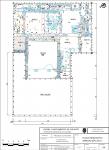Summary (English)
Research (2010-2011)
The excavation carried out on the ‘Roman Villa of the Park of Nations’ site towards the end of 2010 and at the start of 2011 was focussed on expanding the sectors B2, B3, and B5. This has facilitated the discovery of the last wall of the room B2 (the westerb one) as well as new spaces (classified as B6 and B7) which, presumably, are adjacent rooms to B2. It could be an entrance to the rooms B2 and B5 and perhaps even the passage from the work area to the residential area of the villa.
The chronology of the finds lies between the 1st and 4th centuries A.D. Amongst the recovered materials, a Tuscan capital, which belongs to one of the 2 columns found during previous campaigns, stands out. It permits the calculation of the height of this room at, at least, 2.20m. Also, considering that its identification and study could provide interesting data, the find in the UE 1243 of this sector of a stamped imbrex is also important. The appearance of differently made tiles, including some which contain golden mica in their composition, is striking; its source may be in the area of Jumilla (Murcia).
In the sector B2, a large fragment of wall covering has been recovered, which should presumably have wall decoration on its front side. Its biggest point of interest is that the rags which were used in the layers of plaster to stick them to the stone wall have been conserved in the form of wedges. Even the thin limewash that served as a primer to facilitate adhesion has been conserved. This stucco wall fragment will allow an excellent reconstruction of the wall to be made in the villa and will also allow us to discover its decorative repertoire.
(translation by Alex Redmond)
- Natalia Isabel Molinos Navarro
Director
- Pablo Rosser Limiñana y Natalia Isabel Molinos Navarro (COPHIAM)
Team
Research Body
- Diputación de Alicante, Museo Arqueológico de Alicante (MARQ)
Funding Body
- Excmo. Ayuntamiento de Alicante






![Download [PDF]](/excavation/skins/fasti/images/results/download_sml.png)
